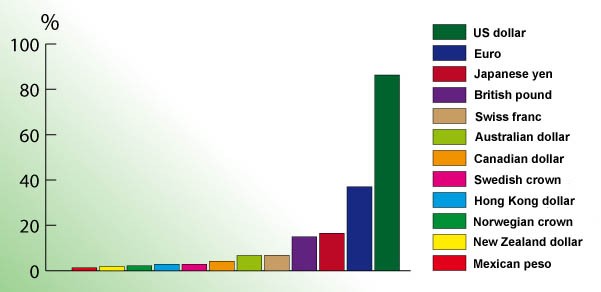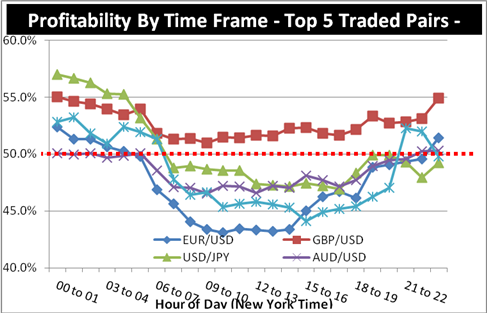The Forex Market Who Trades Currency And Why
Post on: 16 Май, 2015 No Comment

The foreign exchange market (or forex market) is the largest financial market in the world. In fact, the market for currencies is several times larger than the stock market.
This is the place where one currency is exchanged for another, and it has a lot of unique attributes that may come as a surprise for new traders. Here we take an introductory look at the forex market and how and why traders are increasingly flocking toward this type of trading.
What Is Forex?
An exchange rate is the price paid for one currency in exchange for another. It is this type of exchange that drives the forex market.
There are more than 100 different kinds of official currencies in the world. However, most international forex trades and payments are made using the U.S. dollar, yen and euro. Other popular currency trading instruments include the British pound, Australian dollar, Swiss franc, Canadian dollar and Swedish krona.
Currency can be traded through spot transactions, forwards. swaps, and option contracts where the underlying instrument is a currency. Currency trading occurs continuously around the world, 24 hours a day, five days a week. (The line between profitable forex trading and ending up in the red may be as simple as choosing the right account. For more, see Forex Basic: Setting Up An Account. )
Who Trades Forex?
There are many players in the forex market:
The greatest volume of currency is traded in the interbank market. This is where banks of all sizes trade currency with each other and through electronic networks. Big banks account for a large percentage of total currency volume trades. Banks facilitate forex transactions for clients and conduct speculative trades from their own trading desks. When banks act as dealers for clients, the bid-ask spread represents the bank’s profit. Speculative currency trades are executed to profit on currency fluctuations. (Currencies can provide diversification for a portfolio that’s in a rut. Find out which ones you need to know, in Top 8 Most Tradable Currencies. )
Central Banks
Central banks are extremely important players in the forex market. Open market operations and interest rate policies of central banks influence currency rates to a very large extent.
Central banks are responsible for forex fixing. This is the exchange rate regime by which a currency will trade in the open market. Floating. fixed and pegged are the types of exchange rate regimes.
Any action taken by a central bank in the forex market is done to stabilize or increase the competitiveness of that nation’s economy. Central banks (as well as governments and speculators) may engage in currency interventions to make their currencies appreciate or depreciate. During periods of long deflationary trends, for example, a central bank may weaken its own currency by creating additional supply, which is then used to purchase a foreign currency. This effectively weakens the domestic currency, making exports more competitive in the global market. (Central banks use these strategies to calm inflation, but they can also provide longer-term clues for forex traders. For more, see How Inflation-Fighting Techniques Affect The Currency Market. )
Investment Managers and Hedge Funds
After banks, portfolio managers, pooled funds and hedge funds make up the second-biggest collection of players in the forex market. Investment managers trade currencies for large accounts such as pension funds and endowments. An investment manager with an international portfolio will have to purchase and sell currencies to trade foreign securities. Investment managers may also make speculative forex trades. Hedge funds execute speculative currency trades as well.
Corporations
Firms engaged in importing and exporting conduct forex transactions to pay for goods and services. Consider the example of a German solar panel producer that imports American components and sells the final goods in China. After the final sale is made, the Chinese yuan must be converted back to euros. The German firm must exchange euros for dollars to purchase the American components.
Companies trade forex to hedge the risk associated with foreign currency translations. The same German firm might purchase American dollars in the spot market. or enter into a currency swap agreement to obtain dollars in advance of purchasing components from the American company in order to reduce foreign currency exposure risk. (Hedging against currency risk can add a level of safety to your offshore investments. For more, see Protect Your Foreign Investments From Currency Risk. )

The volume of trades made by retail investors is extremely low compared to that of banks and other financial institutions. But the forex trade is growing rapidly in popularity. Retail investors base currency trades on a combination of fundamentals (interest rate parity, inflation rates, monetary policy expectations, etc.) and technical factors (support, resistance, technical indicators, price patterns).
Clearly, forex market participants trade currencies for very different reasons. Speculative trades — executed by banks, financial institutions, hedge funds and individual investors — are profit motivated. Central banks move forex markets dramatically through monetary policy. exchange regime setting, and, in rare cases, currency intervention. Corporations trade currency for global business operations and to hedge risk. (The use of margin to trade in the foreign exchange market can magnify profit opportunities. For more, see Adding Leverage To Your Forex Trading. )
Forex Traders Shape Business
The resulting collaboration of forex traders is a highly liquid, global market that impacts business around the world. Exchange rate movements are a factor in inflation. global corporate earnings and the balance of payments account for each country.
The popular carry trade. for instance, highlights how market participants influence exchange rates that, in turn, have spillover effects on the global economy. The carry trade, executed by banks, hedge funds, investment managers and individual investors, is designed to capture differences in yields across currencies. It is the process of borrowing low-yielding currencies and selling them to purchase high-yielding currencies. For example, if the Japanese yen has a low yield, market participants would sell it and purchase a higher yield currency. (For background reading on this strategy, check out Currency Carry Trades 101 .)
When interest rates in higher yielding countries begin to fall back toward lower yielding countries, the carry trade unwinds and investors sell their higher yielding investments. An unwinding of the yen carry trade may cause large Japanese financial institutions and investors with sizable foreign holdings to move money back into Japan as the spread between foreign yields and domestic yields narrows. This may result in a broad decrease in global equity prices.
The Bottom Line
The carry trade highlights how forex players impact the global economy. Investors can benefit from knowing who trades forex and why they do so.














